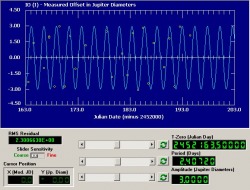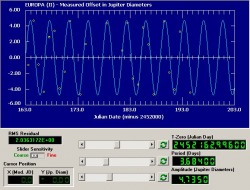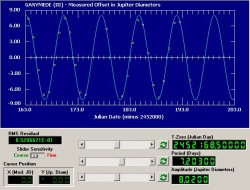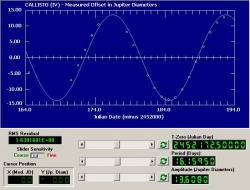Kepler's 3rd Law and the Orbits of the Moons of Jupiter
Objectives:
- Determine the mass of Jupiter.
- Gain a deeper understanding of Kepler's third law
- Learn how to gather and analyze astronomical data
Background:
Planetary motion has been a very popular subject for hundreds of years. Nicolaus Copernicus and Tycho Brahe came up with different theories about the planets that inspired Johannas Kepler to study planetary motion. In this lab, the focus is on Kepler's third law which is about a moon orbiting a much greater body. The formula is C = r3 / T2. Newton expanded Kepler's laws. His findings resulted in various equations: FG = GmM/r^2, mv^2/r=GmM/r^2 etc. When the telescope was invented, things unseen to the naked eye could be measured.
In this lab, we are using the CLEA software in place of our telescopes. The data from that will be like using a telescope. Some days will be cloudy like days that the sky was not visible. The data is supposed to represent real life trial and error of using a telescope to measure the moons of Jupiter.
In this lab, we are using the CLEA software in place of our telescopes. The data from that will be like using a telescope. Some days will be cloudy like days that the sky was not visible. The data is supposed to represent real life trial and error of using a telescope to measure the moons of Jupiter.
Procedure:
The purpose of this lab is to observe the motion of the moons of Jupiter and then use Kepler's third law and the expansion to his law offered by Newton’s Universal Law of Gravitation to deduce the mass of Jupiter. The four Galilean moons, Io, Europa, Ganymede and Callisto are easily seen through a small telescope, and the CLEA software will simulate these observations.
http://mysite.cherokee.k12.ga.us/personal/kimberly_geddes/PhysicsQuests/Kepler%27s%20Laws/keplers_laws_lab.htm
http://mysite.cherokee.k12.ga.us/personal/kimberly_geddes/PhysicsQuests/Kepler%27s%20Laws/keplers_laws_lab.htm
Data:
| Raw Data |
| Table |
Data Analysis:
| Graph |
Concluding Questions:
1. Calculate the percentage error with the accepted mass of Jupiter (1.8986 × 1027 kg).
-Rise/Run (7.36e27-1.0e27)/(1.94e12-0.1e27) = 3.4565e15 = slope
Mass = [ slope * 4(pi)^2 ] / G = 2.04e27
(2.04e27-1.9e27)/(1.9e27) * 100 = 7.67%
2. There are moons beyond the orbit of Callisto. Will they have larger or smaller periods than Callisto? Why?
-The moons will have a larger period. They travel at a slower speed and they have a longer distance to travel to complete one orbit.
3. Which do you think would cause the larger error in MJ: a ten percent error in "T" or a ten percent error in "r"? Why?
-A ten percent error in "r" because it would translate into a greater error with "T" because "r" is needed to find "T"
4. Why were Galileo's observations of the orbits of Jupiter's moons an important piece of evidence supporting the heliocentric model of the universe (or, how were they evidence against the contemporary and officially adopted Aristotelian/Roman Catholic, geocentric view)?
-Galileo realized that the moons of Jupiter actually revolved around Jupiter. This lead to the discovery that other moons revolve around other planets, and planets could even revolve around something bigger, as in the sun. The orbital paths of the moons of Jupiter helped understand the rest of the universe and the different orbital paths that other moons and planets take.
-Rise/Run (7.36e27-1.0e27)/(1.94e12-0.1e27) = 3.4565e15 = slope
Mass = [ slope * 4(pi)^2 ] / G = 2.04e27
(2.04e27-1.9e27)/(1.9e27) * 100 = 7.67%
2. There are moons beyond the orbit of Callisto. Will they have larger or smaller periods than Callisto? Why?
-The moons will have a larger period. They travel at a slower speed and they have a longer distance to travel to complete one orbit.
3. Which do you think would cause the larger error in MJ: a ten percent error in "T" or a ten percent error in "r"? Why?
-A ten percent error in "r" because it would translate into a greater error with "T" because "r" is needed to find "T"
4. Why were Galileo's observations of the orbits of Jupiter's moons an important piece of evidence supporting the heliocentric model of the universe (or, how were they evidence against the contemporary and officially adopted Aristotelian/Roman Catholic, geocentric view)?
-Galileo realized that the moons of Jupiter actually revolved around Jupiter. This lead to the discovery that other moons revolve around other planets, and planets could even revolve around something bigger, as in the sun. The orbital paths of the moons of Jupiter helped understand the rest of the universe and the different orbital paths that other moons and planets take.
Conclusion:
Based on the information I collected from the CLEA software, I concluded that the mass of Jupiter was 2.04e27 kg. This was around 7.67% higher than the actual mass. The reason that the percent error was so high was because collecting the data from the CLEA software was not always accurate, especially if I couldn't zoom in because some of the moons were too far away. This happened mostly with Callisto. Other than that I was able to come up with a close estimate of the mass of Jupiter based only off of the data collected from the CLEA software.




